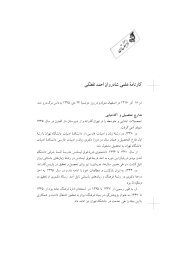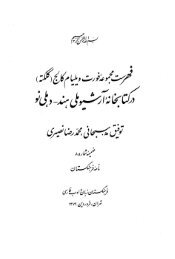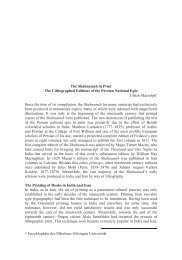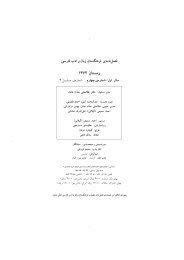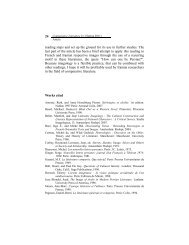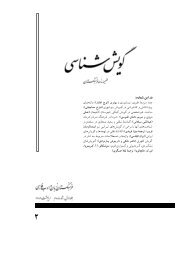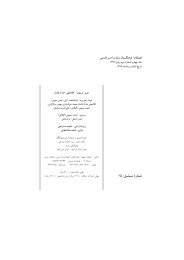Comparative Literature in Arabic: History and Major Tendencies to ...
Comparative Literature in Arabic: History and Major Tendencies to ...
Comparative Literature in Arabic: History and Major Tendencies to ...
You also want an ePaper? Increase the reach of your titles
YUMPU automatically turns print PDFs into web optimized ePapers that Google loves.
12<br />
<strong>Comparative</strong> <strong>Literature</strong> 2:2 (Fall 2011)<br />
Abstracts<br />
<strong>Comparative</strong> <strong>Literature</strong> <strong>in</strong> <strong>Arabic</strong>: <strong>His<strong>to</strong>ry</strong> <strong>and</strong><br />
<strong>Major</strong> <strong>Tendencies</strong> <strong>to</strong> the 1980s<br />
Hussam Al-Khateeb<br />
Qatar University<br />
The orig<strong>in</strong>al article by Hussam Al-Khateeb does not <strong>in</strong>clude an<br />
abstract; however, due <strong>to</strong> our policy <strong>in</strong> <strong>Comparative</strong> <strong>Literature</strong>, we<br />
have added one. This paper has been chosen for translation for several<br />
reasons. 1) Hussam Al-Khateeb is a Syria-born comparatist <strong>and</strong><br />
teaches at Qatar University, <strong>and</strong> has a comprehensive knowledge of<br />
comparative literature <strong>in</strong> the Arab world. 2) The conditions of<br />
comparative literature <strong>in</strong> the Arab world are very similar <strong>to</strong> those <strong>in</strong><br />
Iran so we can benefit from their experiences. 3) This paper is written<br />
by an Arab scholar who has experienced these challenges closely <strong>and</strong><br />
makes a scholarly <strong>and</strong> fair criticism.<br />
In general, the paper studies the emergence <strong>and</strong> development<br />
of comparative literature <strong>in</strong> the Arab world. For the first time,<br />
Egyptian comparatists seriously started <strong>to</strong> study comparative literature<br />
s<strong>in</strong>ce 1980s. Most of Arab comparatists graduated from French<br />
universities <strong>and</strong> were naturally <strong>in</strong>fluenced by the French traditional<br />
school. The works of Guyard <strong>and</strong> Etiémble have been translated <strong>in</strong><strong>to</strong><br />
<strong>Arabic</strong> several times. Mohamed Ghonemi Hilal is the only Egyptian<br />
comparatist who has had a long-last<strong>in</strong>g <strong>in</strong>fluence on comparative<br />
literature <strong>in</strong> the Arab world. Arab universities suffer from lack of<br />
experts <strong>in</strong> comparative literature. Many of <strong>in</strong>struc<strong>to</strong>rs are not<br />
comparatists by academic tra<strong>in</strong><strong>in</strong>g. Accord<strong>in</strong>g <strong>to</strong> Hussam Al-Khateeb,<br />
many of the papers <strong>and</strong> books written <strong>in</strong> <strong>Arabic</strong> do not have anyth<strong>in</strong>g<br />
<strong>to</strong> do with comparative literature <strong>and</strong> just carry its title. Hilal also<br />
blames many of these works for their superficiality <strong>and</strong> lack of depth.<br />
To Hussam Al-Khateeb, many Arab researchers do not consider<br />
comparative literature more than a simple action of comparison. At the<br />
end Hussam Al-Khateeb refers <strong>to</strong> a trend developed by some Arab<br />
comparatists who have a better <strong>and</strong> deeper underst<strong>and</strong><strong>in</strong>g of the new<br />
theories <strong>and</strong> methodology of comparative literature <strong>and</strong> hopes that<br />
they can successfully face the challenges of comparative literature <strong>in</strong><br />
the Arab world as an <strong>in</strong>dependent academic discipl<strong>in</strong>e.<br />
Keywords: <strong>Comparative</strong> literature <strong>in</strong> Egypt, the emergence of comparative<br />
literature <strong>in</strong> Arab countries, Hussam Al-Khateeb, traditional school of<br />
comparative literature, comparative literature theories.
<strong>Comparative</strong> <strong>Literature</strong> 2:2 (Fall 2011)<br />
Abstracts<br />
11<br />
The Emergence <strong>and</strong> Development of <strong>Comparative</strong><br />
<strong>Literature</strong> <strong>in</strong> Spa<strong>in</strong><br />
Nahid Hejazi<br />
The Academy of Persian Language & <strong>Literature</strong><br />
Although modern Spa<strong>in</strong> has established relations with the<br />
European Union <strong>and</strong> has opened her political <strong>and</strong> economic doors <strong>to</strong><br />
the rest of the world, the comparative literature used <strong>to</strong> be considered<br />
marg<strong>in</strong>al. This article reviews <strong>and</strong> analyzes the causes of its<br />
marg<strong>in</strong>alization <strong>and</strong> based on past <strong>and</strong> current status of comparative<br />
literature <strong>in</strong> this country predicts its future. Lack of attention <strong>to</strong><br />
comparative literature <strong>in</strong> Spa<strong>in</strong> has its roots <strong>in</strong> the decl<strong>in</strong>e of her<br />
political <strong>and</strong> economic power over Spanish colonies, dom<strong>in</strong>ation of<br />
fascist regimes, closed doors <strong>to</strong> other countries, <strong>and</strong> <strong>in</strong>volvement <strong>in</strong><br />
civil wars. Fear<strong>in</strong>g <strong>to</strong> lose their national literary identity, made<br />
Spanish researchers hesitant <strong>to</strong> adapt new theories of comparative<br />
literature as expressed <strong>in</strong> other parts of the world. Another reason is<br />
the multiplicity of languages <strong>and</strong> literatures <strong>in</strong> different regions of<br />
Spa<strong>in</strong>, which has caused serious conflicts <strong>and</strong> disagreements among<br />
authors <strong>and</strong> poets. Regional authors usually claimed that the cultural<br />
identity of Spa<strong>in</strong> belonged <strong>to</strong> them <strong>and</strong> this created a gap between<br />
different languages <strong>and</strong> literatures of various regions. Thus,<br />
comparative literature was neglected as a discipl<strong>in</strong>e. From midtwentieth<br />
century with the establishment of the <strong>Comparative</strong><br />
<strong>Literature</strong> Association of Spa<strong>in</strong>, the number of comparative literature<br />
programs <strong>in</strong>creased <strong>in</strong> the Spanish universities as well, <strong>and</strong> the<br />
researches of the prom<strong>in</strong>ent Spanish scholars, like Claudio Guillén,<br />
revived the academic life of this discipl<strong>in</strong>e <strong>in</strong> Spa<strong>in</strong>.<br />
Keywords: <strong>Comparative</strong> <strong>Literature</strong> <strong>in</strong> Spa<strong>in</strong>, Spanish literature,<br />
Claudio Guillén, <strong>Comparative</strong> literature Association of Spa<strong>in</strong>.
10<br />
<strong>Comparative</strong> <strong>Literature</strong> 2:2 (Fall 2011)<br />
Abstracts<br />
<strong>Literature</strong> <strong>and</strong> Pa<strong>in</strong>t<strong>in</strong>g: Blake’s Romantic Pa<strong>in</strong>t<strong>in</strong>gs<br />
from Mil<strong>to</strong>n’s Epic<br />
Laleh Atashi & Alireza Anushiravani<br />
Shiraz University<br />
This paper is an <strong>in</strong>terdiscipl<strong>in</strong>ary research <strong>in</strong> the field of<br />
comparative literature. Blake, the English Romantic poet <strong>and</strong> pa<strong>in</strong>ter,<br />
has expressed his own read<strong>in</strong>g of Mil<strong>to</strong>n’s Paradise Lost <strong>in</strong> his<br />
pa<strong>in</strong>t<strong>in</strong>gs. Generally speak<strong>in</strong>g, the Romantic poets under the <strong>in</strong>fluence<br />
of the dom<strong>in</strong>ant discourse of the French Revolution (1796) were<br />
<strong>in</strong>terested <strong>in</strong> rebellious, unknown <strong>and</strong> mythical characters. Thus,<br />
Mil<strong>to</strong>n’s Satan <strong>in</strong> Paradise Lost which was considered an anti-hero <strong>in</strong><br />
the 18 th century neoclassical poetry, became a hero, who preferred <strong>to</strong><br />
rule <strong>in</strong> hell rather than <strong>to</strong> serve <strong>in</strong> heaven, for the Romantic poets.<br />
However, Blake, the poet, has a completely different read<strong>in</strong>g from<br />
other Romantic poets. Despite his youth <strong>in</strong>terest <strong>in</strong> the French<br />
Revolution, later on Blake became disappo<strong>in</strong>ted with the Revolution<br />
after witness<strong>in</strong>g the aftermath violence. For him, the only solution lied<br />
<strong>in</strong> the creative imag<strong>in</strong>ation <strong>and</strong> thought. Blake drew his pa<strong>in</strong>t<strong>in</strong>g of<br />
Mil<strong>to</strong>n’s Paradise Lost <strong>in</strong> such a spirit. These pa<strong>in</strong>t<strong>in</strong>gs tell us more<br />
about Blake rather than Mil<strong>to</strong>n’s epic.<br />
Keywords: Interdiscipl<strong>in</strong>ary studies, Mil<strong>to</strong>n, Blake, pa<strong>in</strong>t<strong>in</strong>g <strong>and</strong><br />
literature, Paradise Lost, new his<strong>to</strong>ricism, romanticism.
<strong>Comparative</strong> <strong>Literature</strong> 2:2 (Fall 2011)<br />
Abstracts<br />
9<br />
Eliot’s Classicism <strong>and</strong> Wordsworth’s Romanticism<br />
<strong>in</strong> the Context of Nimaic Thought<br />
Behzad Ghaderi Sohi & Nahid Ahmadian<br />
Tehran University<br />
″Arzesh-e Ehsasat″ <strong>and</strong> ″Nameha-ye Hamsaye″, two major<br />
works of Nima Yushij, the modern Persian poet, are among the most<br />
em<strong>in</strong>ent early Persian literary criticism on free verse poetry. In these<br />
two long articles, Nima postulates upon the idea of how free verse<br />
poetry differentiates from the classical counterpart much practiced <strong>and</strong><br />
advocated by the classical poets of both past <strong>and</strong> his contemporary. At<br />
first glance, <strong>and</strong> due <strong>to</strong> his revolutionary reaction aga<strong>in</strong>st the classical<br />
heritage of Persian literature, Nima might have seemed <strong>to</strong> emanate a<br />
radical shift from the tradition of the classical basis. This, however, is<br />
annulled <strong>in</strong> the present article by an attempt <strong>to</strong> excruciate both the<br />
romantic <strong>and</strong> classical foundations of Nima’s ideas. To do this, the<br />
authors have compared <strong>and</strong> contrasted his literary theories <strong>in</strong> the<br />
works mentioned above with the two English counterparts <strong>in</strong> the realm<br />
of classical <strong>and</strong> romantic literary criticism – William Wordsworth <strong>and</strong><br />
his Preface <strong>to</strong> The Lyrical Ballads (1800) <strong>and</strong> T.S. Eliot’s Tradition<br />
<strong>and</strong> the Individual Talent (1919) respectively. The result of this<br />
research <strong>in</strong>troduces Nima as a poet who epi<strong>to</strong>mizes the features of<br />
both Western classical <strong>and</strong> romantic spirit.<br />
Keywords: Eliot, Wordsworth, literary criticism, Romanticism, Classicism.
8<br />
<strong>Comparative</strong> <strong>Literature</strong> 2:2 (Fall 2011)<br />
Abstracts<br />
A <strong>Comparative</strong> Study of Classical Pr<strong>in</strong>ciples <strong>in</strong><br />
Nicola Boileauʼs Art of Poetry <strong>and</strong> Persian <strong>Literature</strong><br />
Mohammad Reza Am<strong>in</strong>i<br />
Shiraz University<br />
The comparative study of literary movements is an important<br />
area of research <strong>in</strong> comparative literature. The School of Classicism<br />
yields itself <strong>to</strong> a comparative study with Persian Classicism. The Art of<br />
Poetry, written by Nicola Boileau, the French poet <strong>and</strong> literary<br />
theorist, is, <strong>in</strong> fact, the manifes<strong>to</strong> of the French Classicism <strong>in</strong> the<br />
seventeenth century. In the first part of the present essay, after a short<br />
review of the cultural <strong>and</strong> literary life of the seventeenth century<br />
France, the basic thoughts of Boileau are elaborated. Then, <strong>to</strong> better<br />
underst<strong>and</strong> the place of Boileau’s art of poetry <strong>in</strong> the his<strong>to</strong>ry of literary<br />
theory, an outl<strong>in</strong>e of this long tradition that beg<strong>in</strong>s with Aris<strong>to</strong>tle <strong>and</strong><br />
cont<strong>in</strong>ues by writers like Long<strong>in</strong>us <strong>and</strong> Horace is drawn. The second<br />
part of the essay deals with the important ideas that Boileau expressed<br />
<strong>in</strong> the first chant of L’art poétique translated entirely here <strong>in</strong> Persian<br />
for the first time. This study shows that Boileau’s Art of Poetry can be<br />
used as an appropriate basis for a comparative study of Persian <strong>and</strong><br />
European classical literature<br />
Keywords: Classicism, Boileau, comparative literature, literary<br />
theory, poetics, classical Persian literature.
<strong>Comparative</strong> <strong>Literature</strong> 2:2 (Fall 2011)<br />
Abstracts<br />
7<br />
Kay Khusrau <strong>in</strong> the Mirror of Eastern <strong>and</strong> Western<br />
<strong>Literature</strong><br />
Afsaneh Kha<strong>to</strong>nabadi<br />
Islamic Azad University, Najafabad Branch<br />
Kay Khusrau, the Persian ideal k<strong>in</strong>g, has been such a<br />
significant character <strong>in</strong> Persian mythology, his<strong>to</strong>ry, national epic,<br />
folktales, transcendental philosophy <strong>and</strong> mystical literature that he has<br />
changed <strong>in</strong><strong>to</strong> a character type. This paper tries <strong>to</strong> exam<strong>in</strong>e the<br />
similarities between Kay Khusrau <strong>and</strong> similar characters <strong>in</strong> the myths,<br />
his<strong>to</strong>ry <strong>and</strong> literature of other nations. Some similar cases could be<br />
found <strong>in</strong> Rigveda, Mahabharata, <strong>and</strong> the Ch<strong>in</strong>ese myths. In addition,<br />
there are significant similarities between Kay Khusrau <strong>and</strong> Feraydoun,<br />
Buddha, Ebrahim Adham, Cyrus the Great, Ardeshir, Al-Hakem,<br />
Romuluy, K<strong>in</strong>g Arthur, as well as Hamlet. On the basis of the present<br />
study, two hypotheses are possible. 1) All these characters have a<br />
common basis, i.e., their background can be traced back <strong>to</strong> Indo-<br />
European mythology, however, they have taken different<br />
manifestations <strong>in</strong> the East <strong>and</strong> West. In other words, it is possible <strong>to</strong><br />
f<strong>in</strong>d an oriental orig<strong>in</strong> for the Kay Khusrau type. 2) The orig<strong>in</strong> of<br />
similarities can be attributed <strong>to</strong> Jungian archetypes <strong>and</strong> the collective<br />
unconscious of human be<strong>in</strong>gs.<br />
Keywords: Kay Khusrau, type, comparative studies, myth, his<strong>to</strong>ry,<br />
epic, archetype.
Abstracts<br />
From Myth <strong>to</strong> <strong>Literature</strong>: The Transition of Oral<br />
Myths <strong>to</strong> Written S<strong>to</strong>ries<br />
Farideh Alavi & Reza Ali-Akbarpour<br />
Tehran University<br />
Myth is one of the prom<strong>in</strong>ent issues <strong>in</strong> comparative literature<br />
studies. The relationship between myth <strong>and</strong> literature seems a bit<br />
problematic as the first one is oral <strong>and</strong> related <strong>to</strong> human beliefs <strong>and</strong> the<br />
second one is written <strong>and</strong> related <strong>to</strong> the realm of aesthetics. However,<br />
further study shows that there are lots of similarities between them <strong>and</strong><br />
both follow the same logic which is that of the s<strong>to</strong>ry. On the other<br />
h<strong>and</strong>, the logic of s<strong>to</strong>ry has its own structure which is rooted <strong>in</strong> the<br />
pr<strong>in</strong>ciples of imag<strong>in</strong>ation. The transition from the oral form of myth <strong>to</strong><br />
the written form of literature has been slow <strong>and</strong> has taken a long time,<br />
dur<strong>in</strong>g which the s<strong>to</strong>ry-teller, audience <strong>and</strong> context have been replaced<br />
by the poet/author, the <strong>in</strong>dividual reader <strong>and</strong> the literary s<strong>to</strong>ry. This<br />
study proves that there are structural similarities between the world of<br />
myth <strong>and</strong> literature <strong>and</strong>, thus, both fit <strong>in</strong><strong>to</strong> a larger framework which is<br />
the world of s<strong>to</strong>ry.<br />
Keywords: Myth, literature, s<strong>to</strong>ry, oral, written, genre, imag<strong>in</strong>ation,<br />
archetype.
<strong>Comparative</strong> <strong>Literature</strong> 2:2 (Fall 2011)<br />
Edi<strong>to</strong>rial<br />
5<br />
comparatists started a new trend after mid-twentieth century which<br />
helped comparative literature <strong>to</strong> flourish <strong>in</strong> Spa<strong>in</strong>. “<strong>Comparative</strong><br />
<strong>Literature</strong> <strong>in</strong> <strong>Arabic</strong>: <strong>His<strong>to</strong>ry</strong> <strong>and</strong> <strong>Major</strong> Issues” is an article written by<br />
Hussam Al-Khateeb, the Syrian comparatist <strong>and</strong> professor of<br />
comparative literature at Qatar University, <strong>and</strong> has been translated <strong>in</strong><strong>to</strong><br />
Persian. It is <strong>in</strong>terest<strong>in</strong>g <strong>to</strong> notice the similar conditions of comparative<br />
literature <strong>in</strong> Arab countries <strong>and</strong> Iran. In the Report section of the<br />
journal, the 20th ICLA Congress <strong>in</strong> 2013, Paris, <strong>and</strong> its major <strong>to</strong>pics<br />
are <strong>in</strong>troduced. The next report is Eugene Chen Eoyang’s<br />
“<strong>Comparative</strong> literature <strong>in</strong> Hong Kong” translated <strong>in</strong><strong>to</strong> Persian. The<br />
aim of these translations is <strong>to</strong> become familiar with current status of<br />
comparative literature <strong>in</strong> other parts of the world <strong>and</strong> <strong>to</strong> benefit from<br />
their experiences. In the Book Review section, David Damrosch’s<br />
What Is World <strong>Literature</strong>? <strong>and</strong> Aldridge’s <strong>Comparative</strong> <strong>Literature</strong>:<br />
Matter And Method are <strong>in</strong>troduced <strong>and</strong> reviewed. The former<br />
<strong>in</strong>troduces a new trend <strong>and</strong> the latter deals with comparative literature<br />
methodology.<br />
The edi<strong>to</strong>rial board of <strong>Comparative</strong> <strong>Literature</strong> of the Academy<br />
of Persian Language <strong>and</strong> <strong>Literature</strong> is happy <strong>to</strong> see that the publication<br />
of four issues has brought about some changes at least among the<br />
younger researchers though it still has a long way <strong>to</strong> go. <strong>Comparative</strong><br />
literature has a broad perspective <strong>and</strong> can bridge literature <strong>to</strong> other<br />
writ<strong>in</strong>gs <strong>and</strong> fields of human knowledge. Thus, its development <strong>in</strong><br />
Iran needs the cooperation of all professors <strong>in</strong> national <strong>and</strong> foreign<br />
literatures as well as those <strong>in</strong> humanities <strong>and</strong> arts. No s<strong>in</strong>gle group can<br />
do this job. Our success depends on how much we can consult <strong>and</strong><br />
work with each other.<br />
Alireza Anushiravani<br />
Associate Edi<strong>to</strong>r
4<br />
<strong>Comparative</strong> <strong>Literature</strong> 2:2 (Fall 2011)<br />
Edi<strong>to</strong>rial<br />
textbooks, <strong>and</strong> <strong>in</strong>ternational conferences <strong>and</strong> their major trends.<br />
Familiarity with the curriculum of comparative literatures <strong>in</strong> the rest<br />
of the world will help us <strong>to</strong> build a program based on our own cultural<br />
<strong>and</strong> social needs. We can, <strong>in</strong>deed, learn a lot from the challenges<br />
others faced <strong>and</strong> the alternatives they came up with. However, our<br />
most urgent need is <strong>to</strong> def<strong>in</strong>e the objective <strong>and</strong> methodology of<br />
comparative literature; otherwise, practical comparative studies with<br />
no deep underst<strong>and</strong><strong>in</strong>g of its new trends will simply lead <strong>to</strong> further<br />
confusion <strong>and</strong> misconception.<br />
The members of the Department of <strong>Comparative</strong> <strong>Literature</strong> at<br />
the Academy of Persian Language <strong>and</strong> <strong>Literature</strong> are presently<br />
work<strong>in</strong>g on the M.A. program <strong>in</strong> <strong>Comparative</strong> <strong>Literature</strong> <strong>in</strong> Iran, <strong>and</strong><br />
will cont<strong>in</strong>ue with the Ph.D. program <strong>in</strong> future, <strong>in</strong> a way <strong>to</strong> update this<br />
discipl<strong>in</strong>e both academically <strong>and</strong> culturally. This is why the edi<strong>to</strong>rial<br />
board of the journal encourages papers which deal with the theoretical<br />
<strong>and</strong> methodological issues. In our last issue, we <strong>in</strong>troduced some of<br />
the new trends of comparative literature, i.e., reception theories, world<br />
literature, translation studies <strong>and</strong> imagology. In this issue we have<br />
<strong>in</strong>cluded papers deal<strong>in</strong>g with characters as types <strong>in</strong> world literature,<br />
literature <strong>and</strong> mythology <strong>and</strong> oral literature, comparative studies of<br />
literary movements <strong>and</strong> genre.<br />
In “From Myth <strong>to</strong> <strong>Literature</strong>: The Transition of Oral Myths <strong>to</strong><br />
Written S<strong>to</strong>ries” Alavi <strong>and</strong> Ali-Akbarpour demonstrate the<br />
relationship between myth <strong>and</strong> literature. In “Kay Khusrau <strong>in</strong> the<br />
Mirror of Eastern <strong>and</strong> Western <strong>Literature</strong>” Kha<strong>to</strong>nabadi traces the<br />
character of Kay Khusrau <strong>in</strong> eastern <strong>and</strong> western literature <strong>and</strong><br />
mythology. She successfully shows how a character reappears <strong>in</strong><br />
different cultures. In “A <strong>Comparative</strong> Study of Classical Pr<strong>in</strong>ciples <strong>in</strong><br />
Nicola Boileauʼs Art of Poetry <strong>and</strong> Persian <strong>Literature</strong>” Am<strong>in</strong>i<br />
compares Boileau’s classicism with that of Persian literature <strong>and</strong><br />
shows their basic similarities. In “Eliot’s Classicism <strong>and</strong><br />
Wordsworth’s Romanticism <strong>in</strong> the Context of Nimaic Poetry”<br />
Ghaderi <strong>and</strong> Ahmadian compare <strong>and</strong> contrast Nima’s literary theories<br />
with those of Wordsworth <strong>and</strong> Eliot <strong>and</strong> conclude how Nima as a<br />
Persian poet epi<strong>to</strong>mizes the features of both Western classical <strong>and</strong><br />
romantic spirit. In “<strong>Literature</strong> <strong>and</strong> Pa<strong>in</strong>t<strong>in</strong>g: Blake’s Romantic<br />
Pa<strong>in</strong>t<strong>in</strong>gs from Mil<strong>to</strong>n’s Epic” Anushiravani <strong>and</strong> Atashi, us<strong>in</strong>g New<br />
His<strong>to</strong>ricism as their theoretical framework, <strong>in</strong>troduce the<br />
<strong>in</strong>terdiscipl<strong>in</strong>ary study of literature <strong>and</strong> pa<strong>in</strong>t<strong>in</strong>g. In “The Emergence<br />
<strong>and</strong> Development of <strong>Comparative</strong> <strong>Literature</strong> <strong>in</strong> Spa<strong>in</strong>” Hejazi studies<br />
the marg<strong>in</strong>alization of comparative literature <strong>in</strong> Spa<strong>in</strong> due <strong>to</strong> its<br />
political <strong>and</strong> economic conditions <strong>and</strong> shows how Spanish
<strong>Comparative</strong> <strong>Literature</strong> 2:2 (Fall 2011)<br />
Edi<strong>to</strong>rial<br />
3<br />
world literature had opened their way <strong>to</strong> comparative literature<br />
studies around the world. This, by no means, was limited <strong>to</strong> Western<br />
universities; Indian <strong>and</strong> Ch<strong>in</strong>ese universities made a considerable<br />
theoretical <strong>and</strong> methodological progress as well. This first step <strong>in</strong> Iran<br />
was, on the one h<strong>and</strong>, encourag<strong>in</strong>g after several decades of negligence,<br />
but, on the other h<strong>and</strong>, serious questions arose that needed reasonable<br />
answers. For sure, the development of <strong>Comparative</strong> <strong>Literature</strong> <strong>in</strong> Iran<br />
needs a strategic <strong>and</strong> long-term plan. The mushroom growth of<br />
comparative literature <strong>in</strong> Iran <strong>in</strong> recent years not only cannot help this<br />
discipl<strong>in</strong>e but it is a fatal blow for this newly cultivated plant. We<br />
must carefully consider our opportunities <strong>and</strong> challenges <strong>and</strong> come up<br />
with a strategic long-term plan for its development. The follow<strong>in</strong>g<br />
questions dem<strong>and</strong> urgent answers <strong>in</strong> the Iranian academia <strong>in</strong>terested <strong>in</strong><br />
comparative literature.<br />
1. How is the theoretical <strong>and</strong> methodological gap go<strong>in</strong>g <strong>to</strong> be<br />
filled?<br />
2. What are the academic criteria for establish<strong>in</strong>g a department<br />
of comparative literature <strong>in</strong> an <strong>in</strong>stitution of higher<br />
education? How far can we cont<strong>in</strong>ue this new trend of<br />
Persian-<strong>Arabic</strong>, Persian-English, Persian-French, …<br />
comparative literature studies? Does it, after all, have any<br />
scientific justification? Is it what we mean by <strong>Comparative</strong><br />
<strong>Literature</strong>?<br />
3. What are the academic qualifications for teachers of<br />
comparative literature? There is no doubt that comparatists<br />
must cooperate with experts <strong>in</strong> national literatures <strong>and</strong><br />
others <strong>in</strong> humanities <strong>and</strong> arts <strong>to</strong> develop a full-fledged<br />
department of comparative literature. Are professors of<br />
Persian or foreign literatures au<strong>to</strong>matically qualified <strong>to</strong><br />
teach comparative literature? Can comparatists by tra<strong>in</strong><strong>in</strong>g<br />
teach all the courses? How can we benefit from team<br />
teach<strong>in</strong>g?<br />
4. What are the qualifications of the applicants <strong>and</strong> what k<strong>in</strong>d<br />
of skills or knowledge are they supposed <strong>to</strong> acquire after<br />
graduation?<br />
5. Do we have enough access <strong>to</strong> comparative literature<br />
textbooks <strong>in</strong> Persian? What is the best solution at this<br />
juncture? Writ<strong>in</strong>g books or translat<strong>in</strong>g from other languages<br />
or both?<br />
We are all familiar with the departments of comparative<br />
literature around the world, the well-known scholars <strong>and</strong> journals <strong>and</strong>
Edi<strong>to</strong>rial<br />
The Necessity of Strategic Plann<strong>in</strong>g for <strong>Comparative</strong><br />
<strong>Literature</strong> <strong>in</strong> Iran<br />
<strong>Comparative</strong> <strong>Literature</strong> <strong>in</strong> Iran was neglected after the early<br />
death of Fatimeh Sayyah (1902-1947) when she was 45 years old.<br />
Why? We still don’t know why comparative literature withered after<br />
her death. Apparently, Syasi, the former chancellor of Tehran<br />
University, decided <strong>to</strong> shut down the program s<strong>in</strong>ce he could not f<strong>in</strong>d<br />
another multil<strong>in</strong>gual faculty member <strong>to</strong> replace her. To lose Sayyah <strong>in</strong><br />
an age when she had just started her scholarly career was a big<br />
tragedy; however, more tragic was the fact that no one was tra<strong>in</strong>ed by<br />
her <strong>to</strong> cont<strong>in</strong>ue her path. Perhaps, because she was academically a<br />
student of French language <strong>and</strong> literature from Moscow University,<br />
comparative literature <strong>to</strong> her was more a matter of personal <strong>in</strong>terest<br />
rather than academic pursuit. Many scholars, <strong>in</strong>clud<strong>in</strong>g Javad Hadidi<br />
(1932-2002) did their best <strong>to</strong> revive this discipl<strong>in</strong>e <strong>in</strong> Iran but their<br />
efforts were scattered <strong>and</strong> did not reach its goals. This his<strong>to</strong>rical<br />
neglect caused a decl<strong>in</strong>e <strong>in</strong> the quantity <strong>and</strong> quality of comparative<br />
literature studies <strong>in</strong> Iran. However, from mid 2001’s, <strong>in</strong> less than six<br />
years, we witness a rapid growth of this discipl<strong>in</strong>e <strong>in</strong> Iran. Several<br />
journals are published dur<strong>in</strong>g these years: The Quarterly of<br />
<strong>Comparative</strong> <strong>Literature</strong> (published by the Islamic Azad University,<br />
Jiroft Branch from Spr<strong>in</strong>g 2007), Journal of <strong>Comparative</strong> <strong>Literature</strong><br />
(published by Kerman University from Autumn 2009), <strong>Comparative</strong><br />
<strong>Literature</strong> (published by the Academy of Persian Language <strong>and</strong><br />
<strong>Literature</strong> from Spr<strong>in</strong>g 2010) <strong>and</strong> <strong>Comparative</strong> Language <strong>and</strong><br />
<strong>Literature</strong> Research (published by Tarbiat Modares University from<br />
Spr<strong>in</strong>g 2010). For the first time, Kerman University admitted M.A.<br />
students <strong>in</strong> <strong>Comparative</strong> <strong>Literature</strong> concentrat<strong>in</strong>g on Persian-<strong>Arabic</strong><br />
literary <strong>in</strong>fluences <strong>and</strong> some conferences were held at different<br />
universities around the country.<br />
Doubtless, comparative literature did not s<strong>to</strong>p <strong>in</strong> other parts of<br />
the world wait<strong>in</strong>g for us. It had progressed specially after midtwentieth<br />
century <strong>and</strong> had distanced itself from the traditional<br />
<strong>in</strong>fluence studies of comparative literature. New areas of studies like<br />
<strong>in</strong>terdiscipl<strong>in</strong>ary studies, translation studies, cultural studies,<br />
globalization <strong>and</strong> multiculturalism <strong>and</strong> most recently a new wave of




